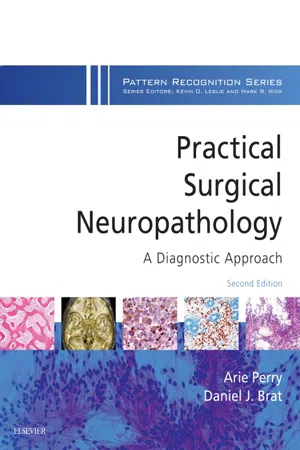
Practical Surgical Neuropathology: A Diagnostic Approach E-Book
A Volume in the Pattern Recognition Series
- 640 pages
- English
- ePUB (mobile friendly)
- Available on iOS & Android
Practical Surgical Neuropathology: A Diagnostic Approach E-Book
A Volume in the Pattern Recognition Series
About this book
Part of the in-depth and practical Pattern Recognition series, Practical Surgical Neuropathology, 2nd Edition, by Drs. Arie Perry and Daniel J. Brat, helps you arrive at an accurate CNS diagnosis by using a pattern-based approach. Leading diagnosticians in neuropathology guide you from a histological (and/or clinical, radiologic, and molecular) pattern, through the appropriate work-up, around the pitfalls, and to the best diagnosis. Almost 2, 000 high-quality illustrations capture key neuropathological patterns for a full range of common and rare conditions, and a "visual index" at the beginning of the book directs you to the exact location of in-depth diagnostic guidance.- Instructive algorithms provide detailed guidance based on 8 major (scanning magnification) patterns and 20 minor (high magnification) patterns – helping you narrow the range of diagnostic possibilities.- A user-friendly design color-codes patterns to specific entities, and key points are summarized in tables, charts, and graphs so you can quickly and easily find what you are looking for.Sweeping content updates.Patterns call-outs throughout. The patterns described initially in the text will be better linked directly within the chapter, reinforcing the patterns for further understanding.
Frequently asked questions
- Essential is ideal for learners and professionals who enjoy exploring a wide range of subjects. Access the Essential Library with 800,000+ trusted titles and best-sellers across business, personal growth, and the humanities. Includes unlimited reading time and Standard Read Aloud voice.
- Complete: Perfect for advanced learners and researchers needing full, unrestricted access. Unlock 1.4M+ books across hundreds of subjects, including academic and specialized titles. The Complete Plan also includes advanced features like Premium Read Aloud and Research Assistant.
Please note we cannot support devices running on iOS 13 and Android 7 or earlier. Learn more about using the app.
Neuropathology Patterns and Introduction
CNS Tumor Classification Schemes and Additional “Neuropathology Patterns”
Table of contents
- Cover image
- Title Page
- Table of Contents
- Pattern Recognition Series
- Copyright
- Contributors
- Series Preface
- Preface
- Acknowledgments
- Practical Surgical Neuropathology Major Patterns
- 1 Neuropathology Patterns and Introduction
- 2 Normal Brain Histopathology
- 3 Intraoperative Consultation and Optimal Processing
- 4 Neuroradiology
- 5 Integrating Molecular Diagnostics With Surgical Neuropathology
- 6 Astrocytic and Oligodendroglial Tumors
- 7 Nondiffuse Astrocytoma Variants
- 8 Ependymomas and Choroid Plexus Tumors
- 9 Other Glial Neoplasms
- 10 Neuronal and Glioneuronal Neoplasms
- 11 Pineal Parenchymal Tumors
- 12 Embryonal Neoplasms of the Central Nervous System
- 13 Meningiomas
- 14 Mesenchymal Tumors of the Central Nervous System
- 15 Tumors of Peripheral Nerve
- 16 Epithelial, Neuroendocrine, and Metastatic Lesions
- 17 Lymphomas and Histiocytic Tumors
- 18 Germ Cell Tumors
- 19 Melanocytic Neoplasms of the Central Nervous System
- 20 Histologic Features of Pituitary Adenomas and Sellar Region Masses
- 21 Therapy-Associated Neuropathology
- 22 Familial Tumor Syndromes
- 23 Infections and Inflammatory Disorders
- 24 White Matter and Myelin Disorders
- 25 Pathology of Epilepsy
- 26 Vascular and Ischemic Disorders
- 27 Biopsy Pathology of Neurodegenerative Disorders in Adults
- Index